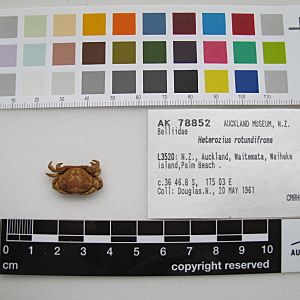Big hand crab facts for kids
Quick facts for kids Big hand crab |
|
|---|---|
 |
|
| Preserved specimen of Heterozius rotundifrons | |
| Scientific classification | |
| Kingdom: | |
| Phylum: | |
| Class: | |
| Order: | |
| Infraorder: | |
| Superfamily: |
Bellioidea
|
| Family: |
Belliidae
|
| Subfamily: |
Heteroziinae
Števčić, 2005
|
| Genus: |
Heterozius
A. Milne-Edwards, 1867
|
| Species: |
H. rotundifrons
|
| Binomial name | |
| Heterozius rotundifrons A. Milne-Edwards, 1867
|
|
The Heterozius rotundifrons, also known as the big hand crab, is a special type of crab. It belongs to the family called Belliidae. This crab is only found in one place: New Zealand. When we say an animal is "endemic" to a place, it means it naturally lives there and nowhere else in the world.
Contents
Meet the Big Hand Crab!
The big hand crab is a fascinating creature from the ocean. It's known for its unique features, which help it survive in its underwater home. Let's dive in and learn more about this interesting crab!
What Makes This Crab Special?
The big hand crab gets its common name from its appearance. While the exact reason for the "big hand" part isn't detailed here, many crabs have one claw that is much larger than the other. This larger claw is often used for fighting, defense, or even attracting a mate.
Where Does It Live?
This crab is a true native of New Zealand. This means you won't find Heterozius rotundifrons living naturally in any other country. It's part of the amazing marine life that makes New Zealand's waters so unique.
How Big Is It?
The big hand crab is not a giant. Its carapace (which is the hard upper shell that covers its body) can grow up to about 25 millimeters wide. To give you an idea, that's roughly the size of a large coin, like a quarter or a 1-inch button.
Its Scientific Name
Every living thing has a scientific name, which is usually in Latin. For the big hand crab, its scientific name is Heterozius rotundifrons. This name helps scientists all over the world know exactly which animal they are talking about, no matter what language they speak.
Why Do Animals Have Scientific Names?
Scientific names are super important! They help avoid confusion because common names can be different in various places. For example, what one person calls a "big hand crab," someone else might call something else. But Heterozius rotundifrons is always the same, everywhere.
The Crab's Family Tree
Just like you have a family tree, animals do too! Scientists group animals based on their shared features. The big hand crab belongs to several groups:
- Kingdom: Animalia (all animals)
- Phylum: Arthropoda (animals with exoskeletons and jointed legs, like insects and spiders)
- Class: Malacostraca (a large group of crustaceans, including crabs, lobsters, and shrimp)
- Order: Decapoda (crabs, lobsters, and shrimp that have ten legs)
- Infraorder: Brachyura (true crabs, which usually have a short, broad body and a tucked-under tail)
- Superfamily: Bellioidea
- Family: Belliidae
- Subfamily: Heteroziinae
- Genus: Heterozius
- Species: H. rotundifrons
This detailed classification helps scientists understand how different species are related to each other.

